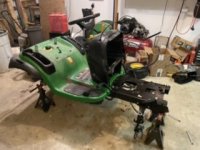- Joined
- Sep 24, 2017
- Threads
- 288
- Messages
- 6,901
time to build a hot rod....
time to build a hot rod....
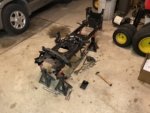
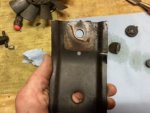
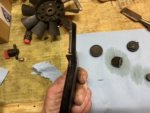
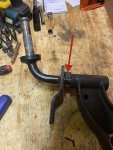
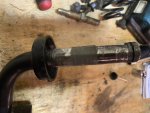
Antiseize Compound.
View attachment 55450
Ok, somebody’s not trying hard enough to stop me from telling myself “while it’s apart I might as well do that too....”
Once I got it cleaned up, I just couldn’t help myself but pull the front axle and transmission. It was just too easy - I’d of had to remove the front axle pivot bolt nut anyway because the anchor plate for the deck’s front adjuster is cracked. I don’t think it’ll take much to repair.
View attachment 55451
View attachment 55452
Except for polishing the front axle bushing surfaces, I’ve got everything cleaned up and ready for assembly, as well as all my replacement parts.
Which reminds me - with the front axle being cast iron, there’s not many options for improvement on the wear surfaces for the spindles without getting too complicated - but I was wondering if anyone has tried using a thrust bearing between the axle and spindle? If so, how did it work out? I don’t expect to eliminate the need for grease by any stretch, but it seems reasonable to think it would reduce the amount of turning effort.
I’ll post some pics for clarity next chance I get.
Dadgumit... you're making me wanna tear my LT120 down. If I didn't still need it to pull my Cyclone leaf sucker upper I'd be tempted to do it. For now I'll watch you have all the fun.So I decided to give up on trying to remove the governor gear and oil pressure relief valve and got the case halves and heads into work to clean in the hot tank. I just made sure to blast them with compressed air and then give them a shot of penetrating oil afterwards.
I was surprised to learn there was an engine under all that filth! ?
I’m going to reassemble the case tonight, then finish cleaning the carbon off the heads and valves tomorrow.
I haven’t yet gotten into the carburetor or the steering/front axle work, but the engine work is going somewhat fast so I’ll probably be there by next week.
Here’s a pic of the chassis. I decided to strip it down this far so I could get it thoroughly cleaned. I’m going to load it on my trailer and take it to the car wash for that. Also a good time to replace the entire fuel line.
View attachment 55285
Educate yourself son:https://www.google.com/search?q=ANT...ome..69i57.36038j0j4&sourceid=chrome&ie=UTF-8Nope, not even a little. My experience with anti-seize compounds in automotive have taught me to only trust it in very specific situations.
Most anti-seize is just grease that has some type of powdered lubricant mixed in with it. For contact areas that don’t need consistent lubrication - threads, mating surfaces between steering knuckles and wheel hubs, or axle shafts and wheel hubs, for example - this is OK; but for contact areas that slide against each other - such as the surfaces on these spindles, or meshing gears - the powdered lubricant can act more like an abrasive and wear them out faster.
In areas of higher temperatures, what little moisture is present in the grease can be dried out, creating even more drag. I’ve seen this countless times when customers think they’re doing good for their cars by applying anti-seize to their wheel lugs - depending on how long the wheels have been on there, the lug nuts are much more difficult to remove. Then I have to spend extra time cleaning/chasing the threads to ensure the lugs are evenly torqued, and a simple service like tire rotation turns into an hour long endeavor when it should only take 10 minutes.
Of course there’s several factors to consider, and I’m not saying there’s no good uses for anti-seize, but I’m very picky about when I use it for anything.
